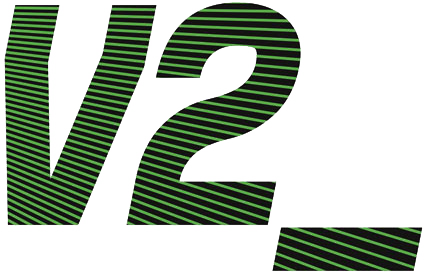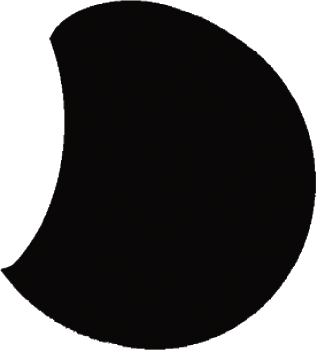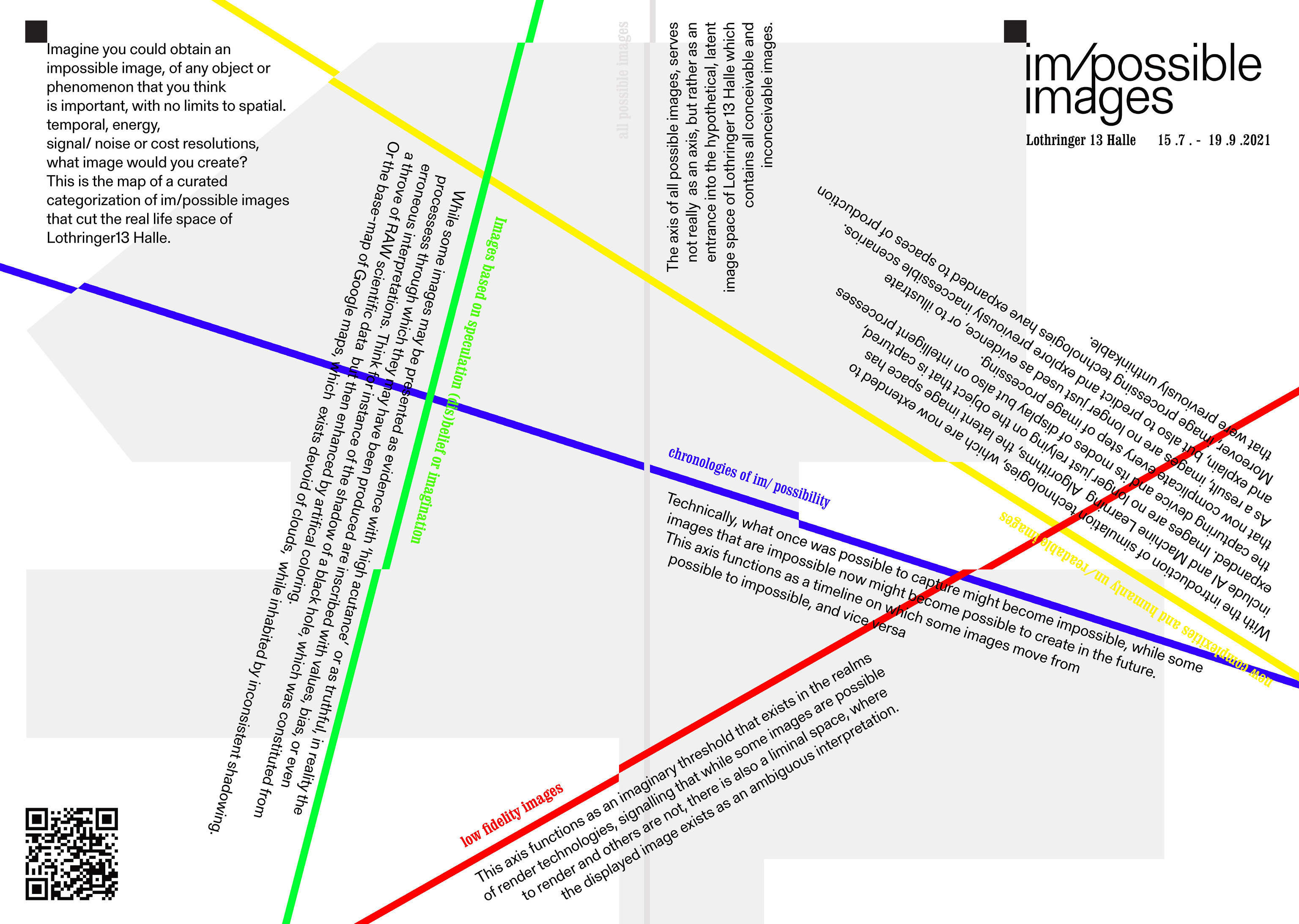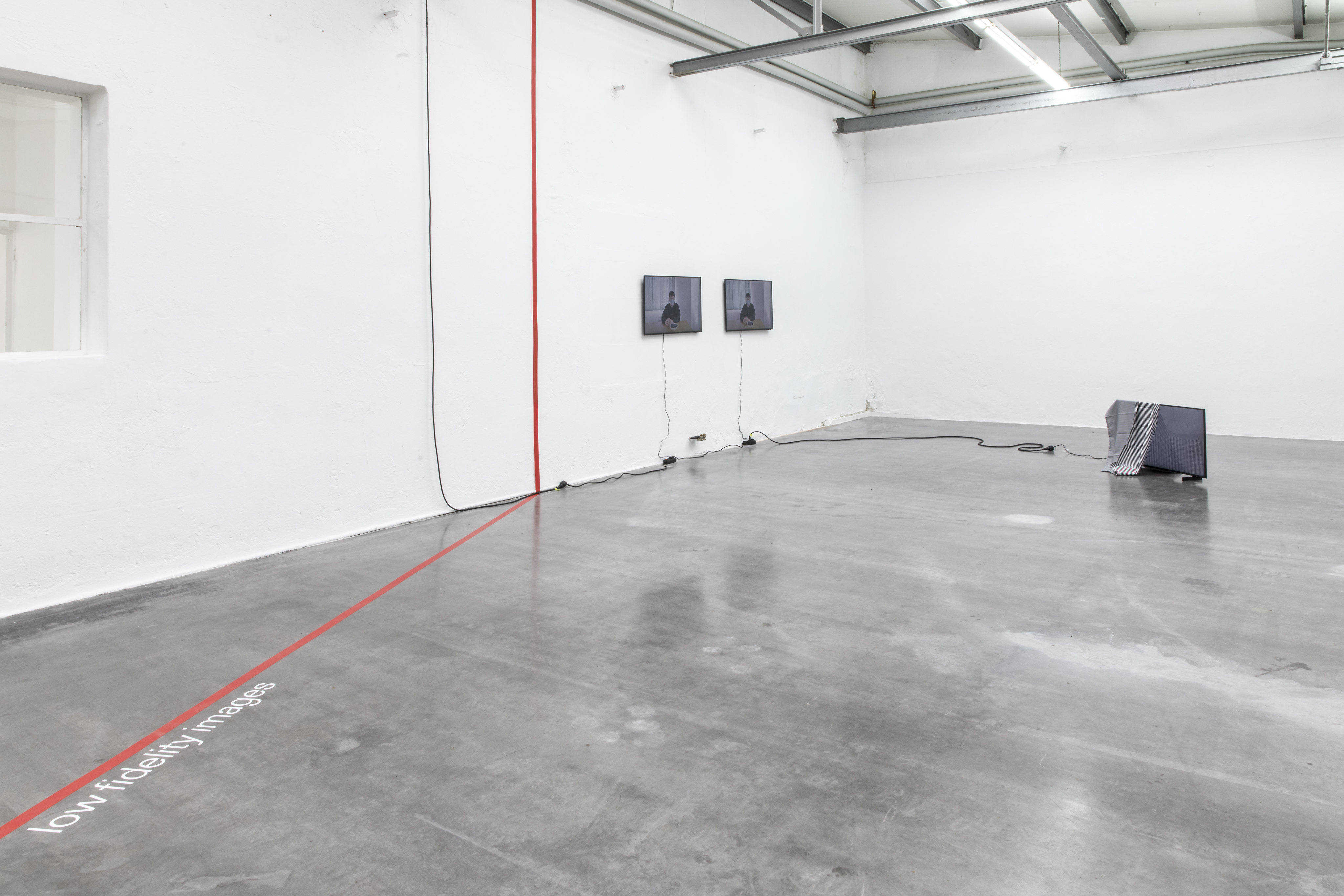
IM/POSSIBLE IMAGES
The 2010s have been a very interesting decade for the creation and generation of images of reality and beyond. The discovery of the Higgs boson particle (2012) and the capturing of the shadow of a black hole (2019) are two of the most prominent examples of science and imagination colliding, shattering the lines of what was previously understood as universal reality. It's been a decade during which it became common knowledge that standard models need extensions, fields of knowledge continuously scale up and down and AI is used pervasively to predict not only the future, but also to see beyond the unseeable. What was once deemed impossible, has become possible.
In 2019 I won the Collide at CERN/Barcelona award with my proposal “Shadow Knowledge”, a project about the fringes of what is enlightened (or: not in the dark). Subsequently, I was awarded a two month residency at CERN, with an additional month in its partnering city of science, Barcelona. In my research proposal, I used the shadow as a metaphor: “In the shadows, things lack definition. The shadows offer shady outlines that can function either as a vector of progress or as a paint by numbers.” I proposed research about what can just be seen or sensed, and about how these new and other techniques can be deployed to derive knowledge about objects of unsupported scale and dimension.
In September that year I finally made it to the largest experiment in the world. But upon arrival at CERN I quickly encountered multiple linguistic clashes. Where I, as an artist, like to use poetic phrases such as Shadow Knowledge, communicating this way with members of the scientific community remained difficult. Our use of language did not jive. Pretty quickly, it became clear I had to cross over to a scientific use of language and find a way to communicate that made sense to the scientists there. A challenge compounded due to differences in language between scientific disciplines, methods, and even experiments.
To consider this challenge I sat down with my two scientific partners: Jeremi Niedziela and Rolf Landua.
With their generous help I reframed my research into a single question:
Imagine you could obtain an 'impossible' image
of any object or phenomenon that you think is important,
with no limits on spatial, temporal, energy, signal/noise or cost resolutions.
What image would you create?
(The answer can be a hypothetical image of course!)
During the three months of my residency I asked every scientist I met this question. Not only for them to consider what images are possible or impossible, but also to probe and isolate the mechanics at work whenever a certain type of image (or rendering) is or becomes ‘impossible,’ or similarly, when a method of rendering gets compromised (deleted, discarded or obsolete). This new method of inquiry worked really well; I rapidly collected countless im/possible images in dialogues with scientists, via email, and through an online form set up for this purpose.
The BLOB of Im/Possible Images // Im/Possible 图像的 BLOB
During the three month CERN Collide and Barcelona residency I asked every scientist I met this question:
Imagine you could obtain an 'impossible' image
of any object or phenomenon that you think is important,
with no limits on spatial, temporal, energy, signal/noise or cost resolutions.
What image would you create?
(The answer can be a hypothetical image of course!)
The collection of "im/possible" images I gathered, reveal both the limitations and possibilities of human imagination and understanding. I compiled the collection into a virtual exhibition named the BLOB (Binary Large OBject) of im/possible images, which offers an immersive environment for visitors to explore and reflect on the nature of imaging. The BLOB not only celebrates the potentialities of images but also emphasizes the constraints and compromises inherent in current image processing technologies.
Imagine you could obtain an 'impossible' image
of any object or phenomenon that you think is important,
with no limits on spatial, temporal, energy, signal/noise or cost resolutions.
What image would you create?
(The answer can be a hypothetical image of course!)
The collection of "im/possible" images I gathered, reveal both the limitations and possibilities of human imagination and understanding. I compiled the collection into a virtual exhibition named the BLOB (Binary Large OBject) of im/possible images, which offers an immersive environment for visitors to explore and reflect on the nature of imaging. The BLOB not only celebrates the potentialities of images but also emphasizes the constraints and compromises inherent in current image processing technologies.

Background story to the BLOB at the Lothringer 13 Halle.
My collection of images displayed the diverse limits of image processing technologies in existence. I learned that some images are currently impossible due to certain restraints (e.g. money or knowledge), while others will remain impossible due to the laws of physics and the universe itself. As such they will forever exist in the hypothetical realms of our imagination.
Using the virtual exhibition toolkit New Art City, I installed a selection of my collection of im/ possible images in a low poly rendition that I named the BLOB of im/possible images. In front of the BLOB (a Binary Large OBject), the visitor is welcomed by the Angel of History who points at the BLOB, urging visitors to enter it. A map reminiscing the realms of Compression Complexities is installed next to her, while behind her the Staircase to Nowhere spirals Northward.
The BLOB was built to give a metaphoric ‘shape’ to the space of all images, past and future. Different Axes of Affordance cut the BLOB. These parameters describe the mechanics that define what is resolved and as a result, what is compromised, or in other words, will not be rendered. While in reality, the space of all im/possible images is fragmented, organized by actions and affordances, stacked by the history of image processing technologies, and consolidated in resolutions, the BLOB offers a space where imaginary propositions are possible. In the BLOB visitors can look and think through images as fluid, released from the otherwise rigid settings, resolutions, affordances and compromises.
Visitors can enter the BLOB through a dark round portal, imaging a Shadow of Dark Matter. Upon entering, they are confronted with A Pale Blue Dot that shines from the depths of the universe, while on the right, The Quantum Vacuum at a Slice of Planck Constant Time flickers rapidly. Right next to it, an image of the insides of a proton shows 3 quarks, the tiniest known building blocks of the universe. Normally, these images are impossible, but the hypothetical realms of the BLOB offer pasture to these im/possible renders.
In the summer of 2021, I was invited by Luzi Gross to conceptualize and curate a physical exhibition of im/possible images at the Lothringer 13 Halle (München). The exhibition was an opportunity to transform the Lothringer into a real space actualisation of the virtual BLOB. In the space of the Lothringer five categories of im/possibility were introduced as parameters or axes of affordances. These axes materialized as architectural elements that physically cut through the rooms of the exhibition halls. But we stopped short of calling the Lothringer a BLOB, instead calling the exhibition the latent space of im/possible images.
In analogue photography, the latent image space exists when photosensitive material has been exposed, but has not gone through a process of development (yet). It is the space that has been touched by light, but that is not showing trace evidence (in the form of an image). The im /possible images show used the term ‘latent image’ as an expanded concept, referring to a hypothetical space that exists before exposure and therefore can still develop every imaginable or unimaginable image.
The main premise of im/possible images is that once any action or decision in the procedure of image processing is initiated, a render parameter is chosen. Following this decision, the parameter operates as a metaphoric cut through the space of everything that can be rendered, dividing it up into images that remain possible, and images that, as a consequence of the decision, are impossible. Effectively, every render setting realizes particular images, while also compromising and complicating others.
In preparation for the show at Lothringer, I went back to my collection of im/possible images. But this time, I did this not to collect images to show, but rather lifted out certain categories I wanted to illustrate via work based in artistic research (as opposed to the mostly scientific illustrations featured in the BLOB).
[ white axis ] all possible images
works:
︎Fabian Heller, All possible images [True Color, Full HD], Print on PVC, 18x2 metres, 2021.
The white axis, the axis of all possible images, starts outside the gallery and serves as the entrance into the hypothetical latent image space of Lothringer 13 Halle. The axis features two works; the BLOB of im/possible images and All Possible Images [True Color, Full HD] (2021). The latter, All Possible Images, is an entirely new, commissioned work by Fabian Heller. In All Possible Images, Heller explores the absolute maximal, finite number of possible renders an HD computer screen can display. Given enough time (and screens to render on), any sequence of pixels - or ways to fill up an HD display - will eventually occur somewhere at some moment in the world. However, the number of images that a FullHD screen can render is immense. It stretches beyond understanding at a human scale - and ushers in a scenario reminiscent of Borges’ Library of Babel and Émile Borels infinite monkey theorem. In an essay in the im/possible images reader Heller therefore concludes that All Possible Images comes with its own impossibilities.
works:
︎Rosa Menkman, BLOB of Im/Possible Images, 3D word, 2021.
The white axis, the axis of all possible images, starts outside the gallery and serves as the entrance into the hypothetical latent image space of Lothringer 13 Halle. The axis features two works; the BLOB of im/possible images and All Possible Images [True Color, Full HD] (2021). The latter, All Possible Images, is an entirely new, commissioned work by Fabian Heller. In All Possible Images, Heller explores the absolute maximal, finite number of possible renders an HD computer screen can display. Given enough time (and screens to render on), any sequence of pixels - or ways to fill up an HD display - will eventually occur somewhere at some moment in the world. However, the number of images that a FullHD screen can render is immense. It stretches beyond understanding at a human scale - and ushers in a scenario reminiscent of Borges’ Library of Babel and Émile Borels infinite monkey theorem. In an essay in the im/possible images reader Heller therefore concludes that All Possible Images comes with its own impossibilities.
[ red axis ] low fidelity images
works:
︎UCNV, Supercritical, Video installation, 2019.
︎Peter Edwards, Nova Drone, Interactive installation, 2012.
30 meters onwards, the white axis intersects with a red axis named the axis of low fidelity images. This red axis functions as an abstract threshold that exists in the realms of digital rendering technologies, beyond the simple binaries otherwise used to understand whether an image can or can not be rendered and features works by UCNV and Peter Edwards.
Images can be amalgamated rather than consolidated. This means that while image data might be static, the final image render is entirely dependent on the discrete steps of the (lofi) image render pipeline. The works exhibited along this red axis illustrate this. They are examples of images existing as non-static formations, or objects of ambiguous technical interpretation, that explore how technological affordances relate to medium specificity, limitation and erroneous consolidation. For instance, Edwards audio visual synthesizer, the Nova Drone, centers around a LED pulsating at high frequency, translated as image-information by the CCD chip (light capturing chip) that exists in most cell phones. Due to the mis-match in frequency between the light pulse of the LED in the Nova Drone and the speed at which the chip of the phone camera collects and writes away the light, a questionable interpretation appears in the memory - the photo roll - of the phone. Whereas Edwards shows how a mismatch in time resolution by our devices can resolve into beautiful, but erroneous, representations, UCNV illustrates how mechanics play out at the level of pixel resolution. His work Supercritical, also represented in an essay in this reader, demonstrates how changes in quantitative pixel resolution result in ambiguous, fluid data morphing. A mechanism that is taken one step further in Daniel Temkin’s contribution to this reader, a how-to guide titled “Unprintables”, which is a manual for creative quantitative pixel resolution mis-use.
works:
︎UCNV, Supercritical, Video installation, 2019.
︎Peter Edwards, Nova Drone, Interactive installation, 2012.
30 meters onwards, the white axis intersects with a red axis named the axis of low fidelity images. This red axis functions as an abstract threshold that exists in the realms of digital rendering technologies, beyond the simple binaries otherwise used to understand whether an image can or can not be rendered and features works by UCNV and Peter Edwards.
Images can be amalgamated rather than consolidated. This means that while image data might be static, the final image render is entirely dependent on the discrete steps of the (lofi) image render pipeline. The works exhibited along this red axis illustrate this. They are examples of images existing as non-static formations, or objects of ambiguous technical interpretation, that explore how technological affordances relate to medium specificity, limitation and erroneous consolidation. For instance, Edwards audio visual synthesizer, the Nova Drone, centers around a LED pulsating at high frequency, translated as image-information by the CCD chip (light capturing chip) that exists in most cell phones. Due to the mis-match in frequency between the light pulse of the LED in the Nova Drone and the speed at which the chip of the phone camera collects and writes away the light, a questionable interpretation appears in the memory - the photo roll - of the phone. Whereas Edwards shows how a mismatch in time resolution by our devices can resolve into beautiful, but erroneous, representations, UCNV illustrates how mechanics play out at the level of pixel resolution. His work Supercritical, also represented in an essay in this reader, demonstrates how changes in quantitative pixel resolution result in ambiguous, fluid data morphing. A mechanism that is taken one step further in Daniel Temkin’s contribution to this reader, a how-to guide titled “Unprintables”, which is a manual for creative quantitative pixel resolution mis-use.
[ green axis ] images based on speculation, dis/belief or imagination
works:
︎Susan Schuppli, Can the sun lie? Video, 2014–2015
︎Sasha Engelmann & Sophie Dyer, Open Weather, Installation & Workshop, 2020-2021
︎Rosa Menkman, Whiteout, video (15 min.), 2020
︎Quote by Ingrid Burrington "forever noon on a cloudless day"
︎NASA basemap of Earth.
A green axis titled images based on speculation, dis/belief or imagination runs almost perpendicular to the red axis. The works installed along this axis show the complex dynamic in images that are presented as evidentiary, truthful or scientific. They illustrate that all processes of image sourcing inevitably inscribe them with values, bias or even faulty interpretations.
One evocative example in the exhibition is the basemap of planet Earth. A map completely devoid of clouds, inhabited by inconsistent shadowing and a blanketing noon time zone - or as Ingrid Burrington rightfully states: on the basemap of planet Earth, it is “forever noon on a cloudless day.” In this reader there are three texts accompanying the green axis. First, a reprint of Susan Schuppli’s formidable essay Can the Sun Lie (2014-2015), in which she shares a striking account of how a system of belief can thwart scientific inquiry. Secondly, the manual for the open weather workshop that was used during the im/possible summer school at the Lothringer. With the help of this manual, one can listen to the NOAA satellites and decode their radio transmission to create a local weather report that goes beyond values of precipitation and temperature, but highlights under-represented values like smog, light or other environmental conditions (of pollution). The axis concludes with “Whiteout”, in which I tell the story of an exhausting mountain hike during a snowstorm and the experience of the loss of my physical sensations - leading to an inability to see, hear, or orient myself. While the spatial dimensions are at first seemingly wiped out, an experience of oversaturation starts to offer the environment to me in new, different imagery ways.
works:
︎Susan Schuppli, Can the sun lie? Video, 2014–2015
︎Sasha Engelmann & Sophie Dyer, Open Weather, Installation & Workshop, 2020-2021
︎Rosa Menkman, Whiteout, video (15 min.), 2020
︎Quote by Ingrid Burrington "forever noon on a cloudless day"
︎NASA basemap of Earth.
A green axis titled images based on speculation, dis/belief or imagination runs almost perpendicular to the red axis. The works installed along this axis show the complex dynamic in images that are presented as evidentiary, truthful or scientific. They illustrate that all processes of image sourcing inevitably inscribe them with values, bias or even faulty interpretations.
One evocative example in the exhibition is the basemap of planet Earth. A map completely devoid of clouds, inhabited by inconsistent shadowing and a blanketing noon time zone - or as Ingrid Burrington rightfully states: on the basemap of planet Earth, it is “forever noon on a cloudless day.” In this reader there are three texts accompanying the green axis. First, a reprint of Susan Schuppli’s formidable essay Can the Sun Lie (2014-2015), in which she shares a striking account of how a system of belief can thwart scientific inquiry. Secondly, the manual for the open weather workshop that was used during the im/possible summer school at the Lothringer. With the help of this manual, one can listen to the NOAA satellites and decode their radio transmission to create a local weather report that goes beyond values of precipitation and temperature, but highlights under-represented values like smog, light or other environmental conditions (of pollution). The axis concludes with “Whiteout”, in which I tell the story of an exhausting mountain hike during a snowstorm and the experience of the loss of my physical sensations - leading to an inability to see, hear, or orient myself. While the spatial dimensions are at first seemingly wiped out, an experience of oversaturation starts to offer the environment to me in new, different imagery ways.
documentation:
︎Röntgen, Röntgen photo, print, 1896
︎NASA Voyager / Carl Sagan, Pale blue dot, 1990
︎Medipix, spectroscopic X-ray 2018
[ yellow axis ] new complexities and humanly un/readable images
works:
︎Alan Warburton, RGB FAQ, Video essay (27:38 min), 2020
︎Memo Akten, Learning to See: Gloomy Sunday, HD Video (3:02 min), 2017
︎Rosa Menkman, Shredded Hologram Rose (4:30 min) 2021
Finally, the yellow axis presents new complexities and humanly un/readable images. This axis focuses on new layers of image processing, added since the advent of AI image generation. During the exhibition in the Lothringer Alan Warburtons video essay RGBFAQ, of which the text is reproduced in this reader, was seen in the basement. In RGBFAQ, Warburton asks what the computational image is? Completing the axis are Memo Aktens’ Learning to See (2017) and The Shredded Hologram Rose (Rosa Menkman, 2021).
works:
︎Alan Warburton, RGB FAQ, Video essay (27:38 min), 2020
︎Memo Akten, Learning to See: Gloomy Sunday, HD Video (3:02 min), 2017
︎Rosa Menkman, Shredded Hologram Rose (4:30 min) 2021
Finally, the yellow axis presents new complexities and humanly un/readable images. This axis focuses on new layers of image processing, added since the advent of AI image generation. During the exhibition in the Lothringer Alan Warburtons video essay RGBFAQ, of which the text is reproduced in this reader, was seen in the basement. In RGBFAQ, Warburton asks what the computational image is? Completing the axis are Memo Aktens’ Learning to See (2017) and The Shredded Hologram Rose (Rosa Menkman, 2021).
The Im/Possible Images Reader
I initiated my - still in progress - research on im/possible images with a single question: Imagine you could obtain an 'impossible' image of any object or phenomenon that you think is important, with no limits on spatial, temporal, energy, signal/noise or cost resolutions. What image would you create? (the answer can be a hypothetical image of course!)
The Im/Possible Images Reader represents a moment in my journey to reflect on my progress and constitutes a collection of texts that range from short stories, to image work, manuals, (technical) documentation and essays that I consider to constitute valuable responses to this question. Some of these materials were specifically written for this reader, whereas others have been generously allowed to be reprinted.
The organization of this publication is modular; the chapters can be read independently. Despite this, we chose the order in which we present them for a reason: to provide a consistently additive flow that builds outwards from the five axes of the exhibition.
In conclusion, I would like to stress that after releasing this im /possible images reader, im /possible images will remain an active research platform, which can be visited here:
www.beyondresolution.info/impossible
The Im/Possible Images Reader represents a moment in my journey to reflect on my progress and constitutes a collection of texts that range from short stories, to image work, manuals, (technical) documentation and essays that I consider to constitute valuable responses to this question. Some of these materials were specifically written for this reader, whereas others have been generously allowed to be reprinted.
The organization of this publication is modular; the chapters can be read independently. Despite this, we chose the order in which we present them for a reason: to provide a consistently additive flow that builds outwards from the five axes of the exhibition.
In conclusion, I would like to stress that after releasing this im /possible images reader, im /possible images will remain an active research platform, which can be visited here:
www.beyondresolution.info/impossible
 Part of the research for this reader was conducted in the framework of the Alex Adriaansens Residency at V2_Lab for the Unstable Media. Thanks to director Michel van Dartel and curator Florian Weigl.
Part of the research for this reader was conducted in the framework of the Alex Adriaansens Residency at V2_Lab for the Unstable Media. Thanks to director Michel van Dartel and curator Florian Weigl.MATERIALS
︎Rosa Menkman & Luzi Gross – im/possible images introduction and exhibition documentation
︎Fabian Heller – All Possible Images
︎UCNV – Into Supercritical
︎Daniel Temkin – Unprintables
︎OPEN WEATHER (Sasha Engelmann & Sophie Dyer) – The Im/Possible Weather Station & Workshop
︎Susan Schuppli – Can the Sun Lie?
︎Rosa Menkman – Whiteout
︎Alan Warburton – RGBFAQ
︎Klasse Digitale Grafik HfBK Hamburg – projects on im/possible images
︎Fabian Heller – All Possible Images
︎UCNV – Into Supercritical
︎Daniel Temkin – Unprintables
︎OPEN WEATHER (Sasha Engelmann & Sophie Dyer) – The Im/Possible Weather Station & Workshop
︎Susan Schuppli – Can the Sun Lie?
︎Rosa Menkman – Whiteout
︎Alan Warburton – RGBFAQ
︎Klasse Digitale Grafik HfBK Hamburg – projects on im/possible images










